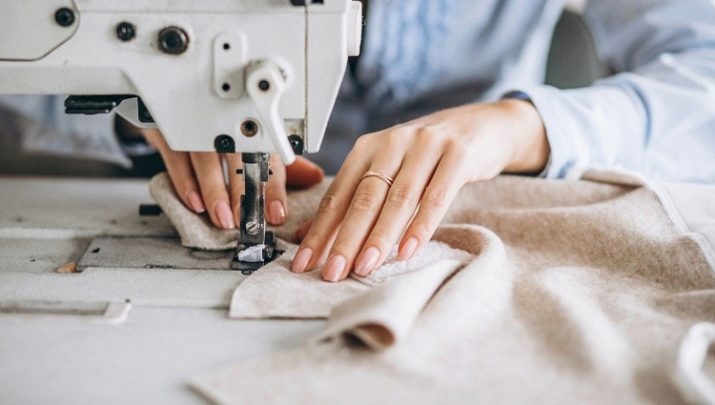Choosing a sewing table
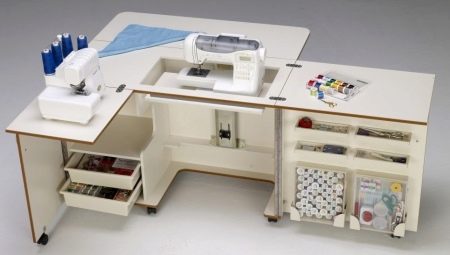
Each seamstress tries to properly organize her workspace based on her preferences, capabilities, and budget. Many of them are content with a simple writing desk, while others purchase special sewing tables.
How to choose the right surface for a typewriter in order to work comfortably and save your time? To do this, you need to familiarize yourself with all the options for sewing tables.
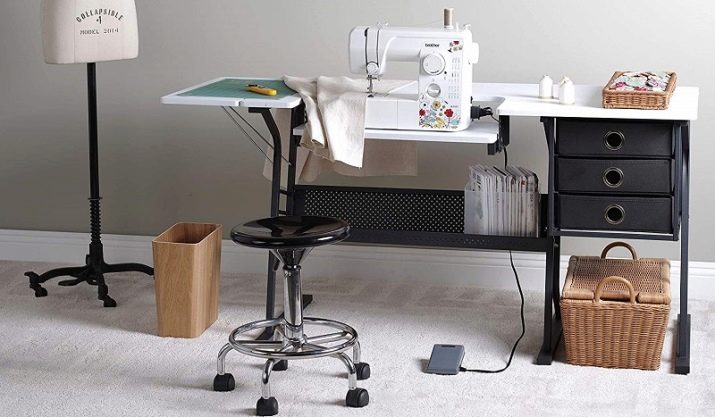
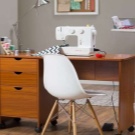
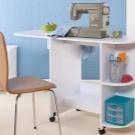
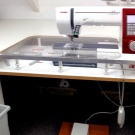
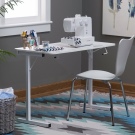
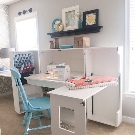
Peculiarities
If we consider sewing furniture for cutting and sewing, then it is somewhat different from the tables we are used to (writing or dining) and a number of other furniture. Sewing tables for a typewriter or overlock, as well as for any other needlework, differ in that they are specially modeled for a certain type of technique.
Such furniture should be equipped with everything necessary for the sewing process. Most often, in such tables you can find a large number of different boxes, which differ in size and filling (with special spools for spools or additional shelves).
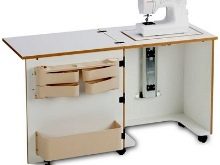
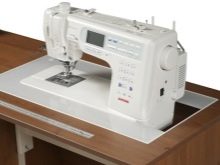

The dimensions of the table are always selected based not only on the area of the room, but also taking into account the fact that on such a surface it is often necessary to cut different fabrics... It is necessary that the pattern fits correctly and well on the surface. If the transfer of the pattern is carried out incorrectly or with large errors, it will not work to sew the product. A modern sewing table is a kind of transformer that modifies the work surface in a way that is convenient for the seamstress, and also makes it easier to store equipment and other accessories.
For example, if there are animals or small children in the house, then with special furniture you no longer need to be afraid that equipment or needles and coils may suffer or harm someone.

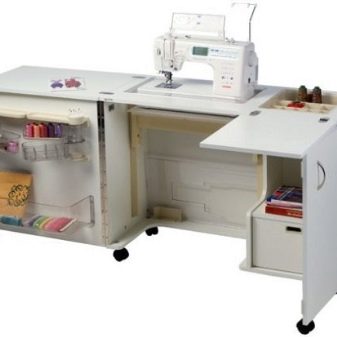
Species overview
Any sewing table that will be designed for both home use and production, be it a fold-out or a shortened one, will always make all kinds of sewing work easier. The furniture contains special compartments for a sewing machine, overlocker, carpetlock or a cover sewing machine. The worktop has compartments for tools or fabrics.
There are a large number of different surfaces for a machine on the market, which differ in functionality (for an industrial or household machine), cost, materials used, additional functions, as well as in shape and purpose. But among this variety, you can choose the ideal option if you know the features of all types.
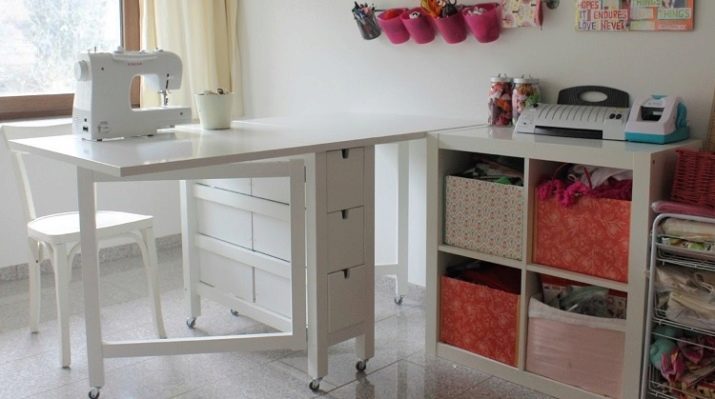
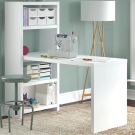
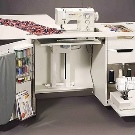
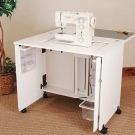
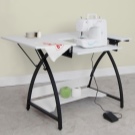
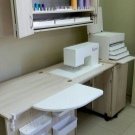
Let's consider each type separately and highlight some of their advantages.
- Classic table. One of the most popular models, featuring a large working surface, which is used not only for sewing, but also for closing. Such furniture can be found in any atelier or sewing workshop. The main feature of this model is that the machine is fixed directly on the surface itself, it does not hide under the table or can not be removed. The surface is not foldable, therefore it takes up more space. This is the plus and minus of these tables. The features also include the fact that the legs can be adjusted in height based on the height of the person, as well as the necessary work. A spreading carriage is installed on such tables, which helps in cutting fabric.
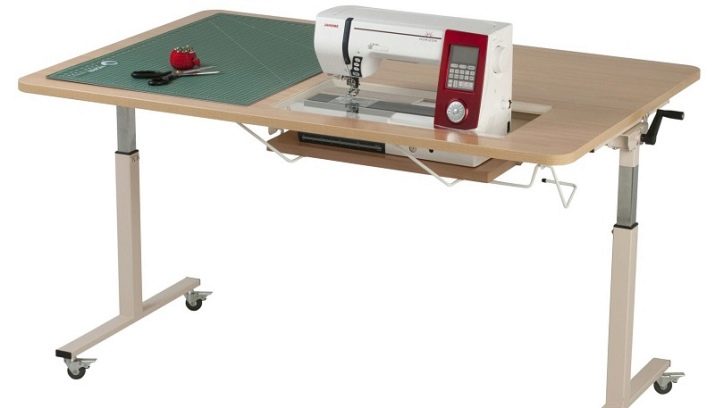
- Multifunctional surfaces. Most often they are used for a home workshop, since they are several modules. They are angular, less often with the letter "P". The model carries a number of basic and additional functions. The peculiarity of this table is that the modules can be compactly folded and, as a result, formed into one large cabinet. A large number of useful additional sections and compartments are made in the lockers. The main advantage of the surface is that if you hide all the equipment in cabinets or drawers, then a large and free part is formed for cutting fabric.
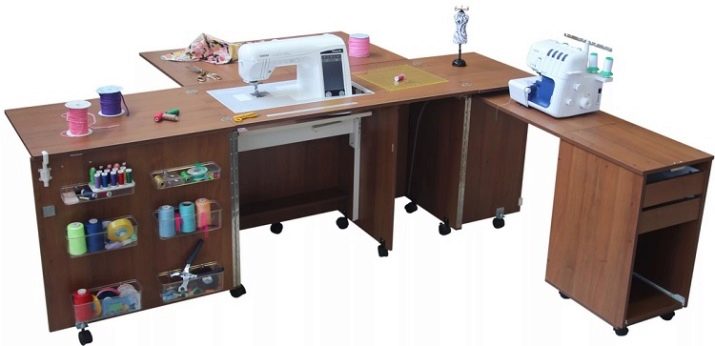
- With built-in light... Such tables are easy to use, as there is no need to think over a special light for the table in the workshop. They are not in great demand among the craftswomen. But for some, this feature is considered a big advantage.
Built-in lighting is used on any surface, most often in multifunctional tables or transforming tables.
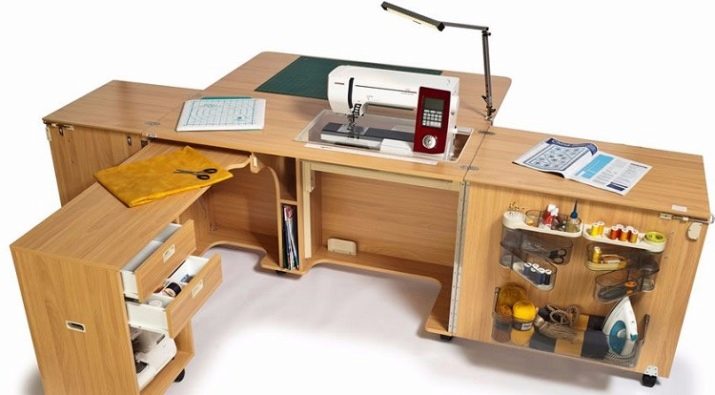
- Book tables. A budget option, with which a large number of craftsmen and craftswomen start. The table is the simplest in functionality, it does not have any additional sections or compartments, except for storing a typewriter and small accessories. Consists of three parts: a central one that moves and two lifting table tops. Suitable for seamstresses who do not sew too often and do not have specific work surface requirements. The advantage of this model is its small size and compactness. Mobility and accessibility are also positives for many. Now on the market there are two options for tables: the first option is a simple table-book, and the second is a more advanced model with additional storage compartments or a mechanism for raising the machine.
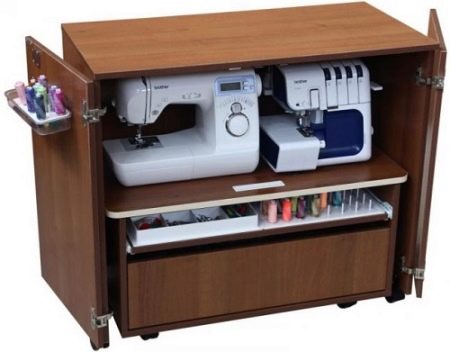
- Transformers... Convenient and compact tables for sewing and cutting. They are distinguished by their practicality and versatility. They have a large number of different storage compartments, shelves, boxes for fittings. The advantage of the surface is that it does not take up much space, and when folded can be used as a writing table. Suitable for a wide range of sewing techniques.
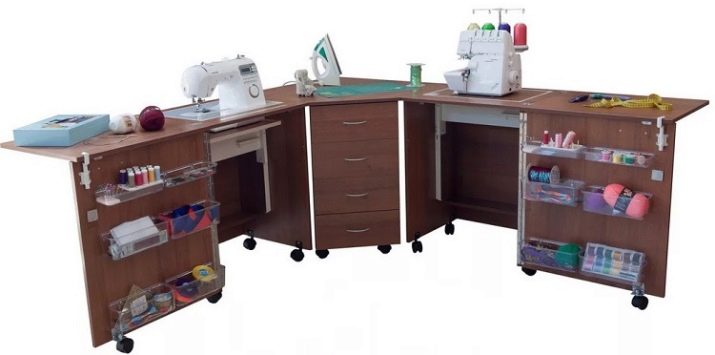
- Professional work surfaces... They are large in size, so they are not suitable for those seamstresses who are engaged in sewing from time to time. They combine a cutting table and surface for modeling patterns and sewing techniques. The legs of such tables can be adjusted in height, and there are also special pedals. If desired, this model can be manually equipped with special drawers and additional storage compartments or pencil cases in which you can put your sewing machine or other equipment. The surface is often used as an ironing board. Although this model is in demand, it has a very high price tag.
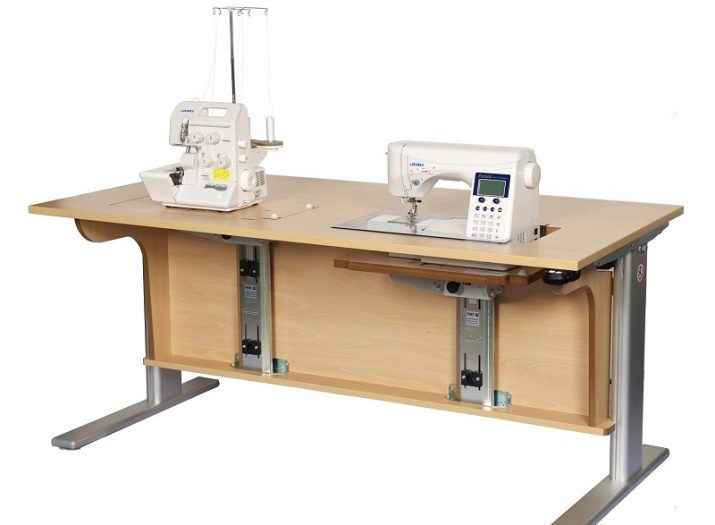
- Corner... They have a spacious work surface. Consist of three main parts. The left side is usually folding and is a continuation of the surface of the main table. A machine is installed on it. It is often equipped with a special mechanism that hides the machine inside. The right side forms a right angle, this is where the overlock or any other additional technique is stored.
It is good to cut, iron and sew on the corner table. For some, the overpriced is considered a significant disadvantage.
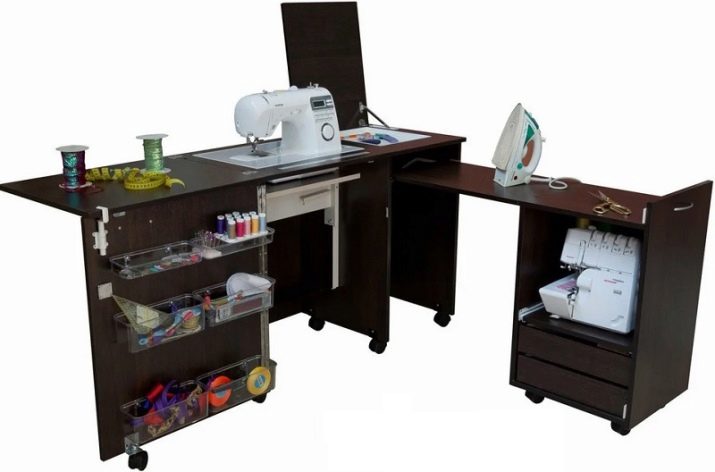
- In the form of a curbstone. One of the most budgetary options, the second after the table-book. Available in several sizes on the market, the models differ in their functionality. It is a nightstand for equipment, where different devices are stored. And also there is a variant of a chest of drawers. In some models, only a sewing machine can be stored, while larger designs have the ability to store an overlock or a cover sewing machine. The model has more free space. Tables can be equipped with an additional screw-on cutting surface. There are often small pockets on the doors where you can store scissors or any other small accessories. You don't have to unfold it completely. Differs in compact dimensions.
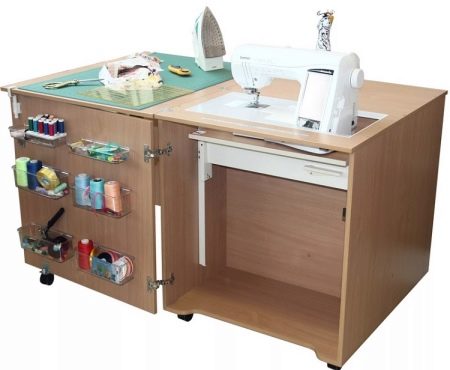
Materials (edit)
Tables differ not only in their functionality and dimensions, but also in the materials from which they are made. Let's consider the most popular materials at the moment.
- The most natural of all materials is, of course, wood.... The finest material that has a large number of positive characteristics. For example, wear resistance and durability. Wood has high strength, so such models are more often than others chosen in sewing shops when the tabletop is used repeatedly. The tree is not afraid of temperature extremes, so it feels great in heated and unheated rooms. You can safely put a hot iron on the wood panel. The main disadvantages that make you think about buying a table from this material are weight (wood is very heavy) and cost. More often than others, wood is used to create professional tables.
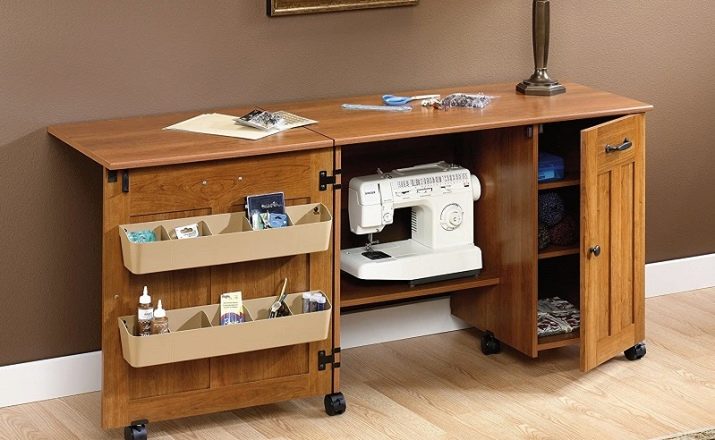
- Chipboard. A very cheap and lightweight material that is not very practical. Furniture made of this material is attractive in appearance, but its disadvantages very much overlap even a low cost. Chipboard absorbs moisture very strongly, crumbles and crumbles, and deformation can begin under heavy weight. You shouldn't trust too much the varnish that is applied to the surface. It will extend the service life of the product, but does not fully guarantee long-term operation.
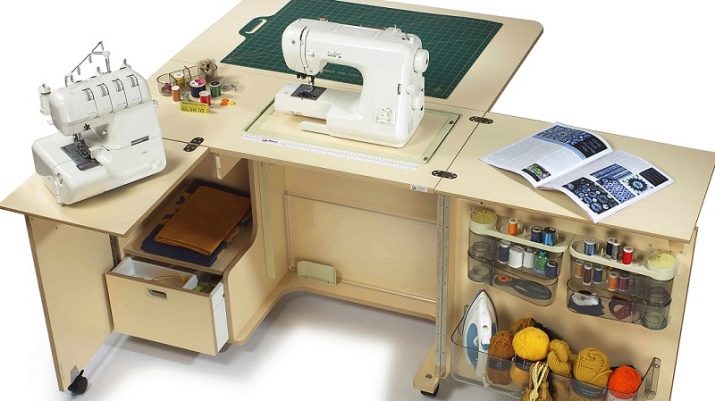
- Chipboard... An improved version of the previous material. The main advantage is that the composition contains resins that hold the structure together (namely pressed sawdust), making the surface more durable and stable. Chipboard has good temperature resistance. The material is easy to process, very cheap, flexible and unpretentious.
Most of the middle class models are made from this material.
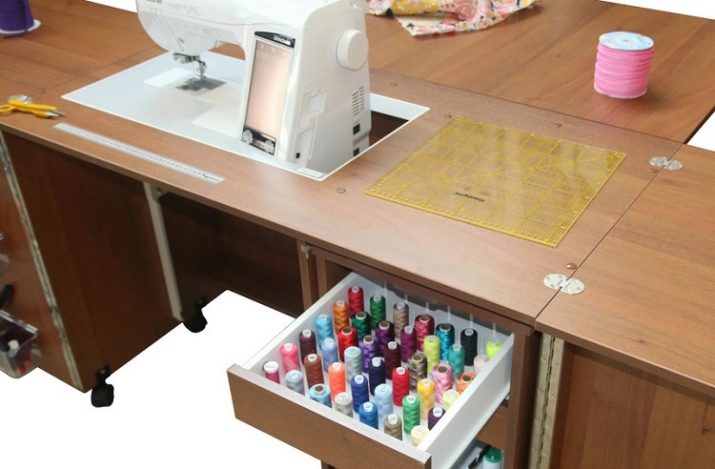
- MDF... It is famous for its lightness and cheapness. Used for self-manufacturing of a sewing table.The factory models are equipped with casters that make the furniture more mobile, and the light weight ensures that the floor does not sell under the weight. The downside of this material is that it is short-lived, does not tolerate moisture and temperature changes. Untreated hob surfaces can swell over time from direct steam or even a simple mug of tea. Additional surface treatment or protection (eg glass) is required.

The best manufacturers and models
In any furniture or specialized sewing stores, a large assortment of sewing tables of one or another configuration is presented. You can choose any model to your taste and budget. On the domestic market, there are models of such companies as Vistex, Comfort and the German company RMF.
Let's take a look at a few popular tables that are most in demand.
- "Comfort-5". A compact table that is ideal for any room. It is equipped with several drawers and special hinged containers that are attached to the doors. And also there is a folding surface.
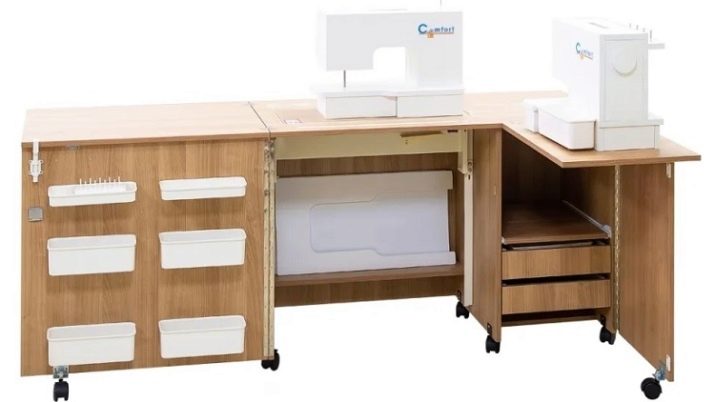
- "Seamstress-4". A small pedestal table that has a main work surface, as well as storage space for a sewing machine and small accessories or fittings. There is a small drawer under the countertop where you can fold threads, scissors or special containers. Ideal for small spaces or for craftswomen who are just mastering sewing.
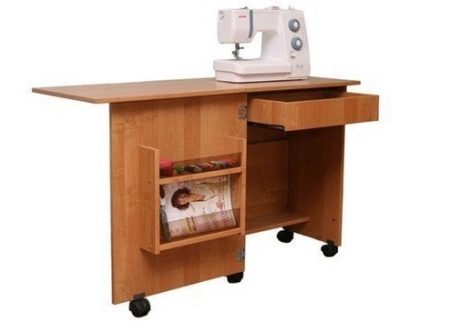
- RMF 38.50. The model accommodates not only a typewriter, but also an overlock. The plus is the large space for cutting and ironing. Drawers, reel slots, compartments for other fittings are also available.
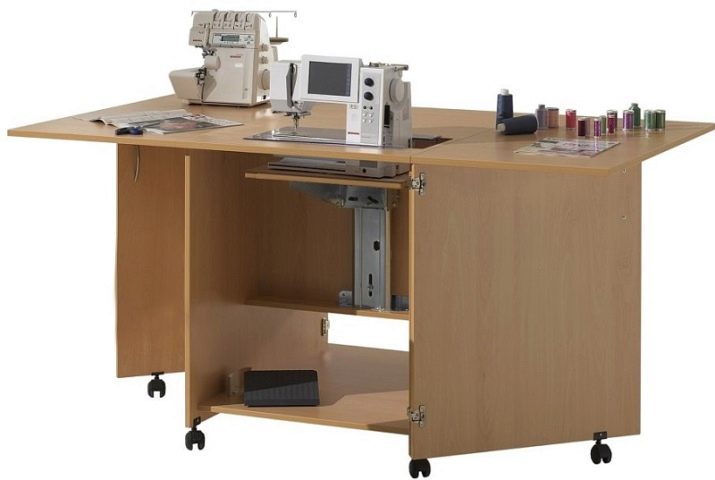
- "Comfort 1-Q". Has a large work surface. The model accommodates several cars. The main one is attached to a surface that has a lowering and raising mechanisms. Inside, there are additionally 5 storage boxes, several large compartments, where you can store fabric or magazines. The door walls are equipped with hanging shelves, on which it is convenient to store spools of thread. There are casters that make this table more mobile. The set includes a comfortable chair. Table height 85.3 cm.
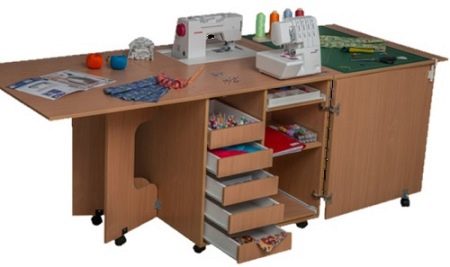
- "Seamstress - 1". A modular corner table that accommodates an extra surface that can be used as an ironing board. There are several storage compartments inside, but no drawers. When folded, it is a large double-leaf pedestal.
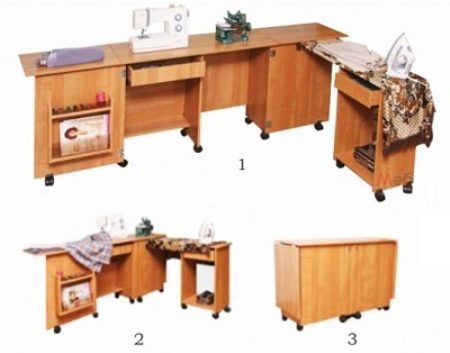
Criterias of choice
When buying a table, you should always consider some points that will help you choose the perfect table that will harmoniously fit into your work area. The first thing worth paying attention to is the place where the table will stand. This is important, since this or that design will be selected from the calculations of the useful area. If the room is small, then you should choose a book-table or a table in the form of a curbstone. These models are very compact and do not take up much space.
If space permits, then you can use transforming tables. They can be adjusted in size, height, and they are equipped with wheels, which makes the table very mobile. Separately, it is worth considering the dimensions of the sewing machine. Many simple household machines are standard (small) sizes. But if the equipment is professional and completely assembled from metal, then simple small countertops will not be able to withstand its mass.
In addition to the size, it is necessary to take into account the amount of equipment used.
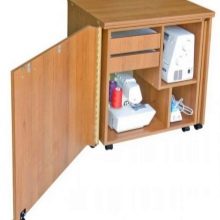
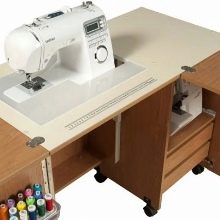
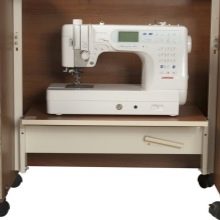
The next criterion is material. It is worth dwelling on this point a little longer, since the durability and practicality of the product depend on the material. It is also important to remember how often the work surface will be used.... And also components can be attributed here, for example, the mechanism for raising and lowering the machine. It is worth making sure that it is reliable and that the mounts are working properly.Otherwise, during operation, the lowering mechanism may be triggered due to excessive pressure force. When buying, you should think about additional cells or shelves.
Not all tables are equipped with such useful features. The cheaper the model, the less it contains all the components, including the shelves. You need to decide and understand how many accessories are available at the moment. If a seamstress is just starting to sew, then she may think that she does not need such an addition, but over time this may change. It is best to choose a table with at least a small number of shelves or drawers for storage.
Another important point that most seamstresses overlook is the cutting surface. Small tables are not equipped with such a useful surface, since they are small in size. In this case, it will be necessary to cut on a different surface.
